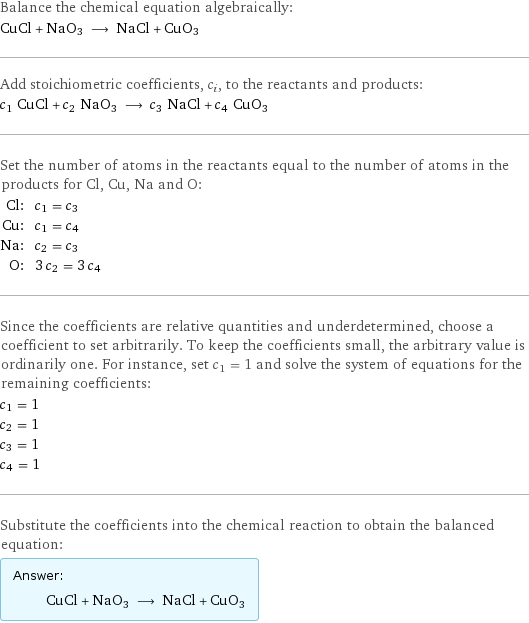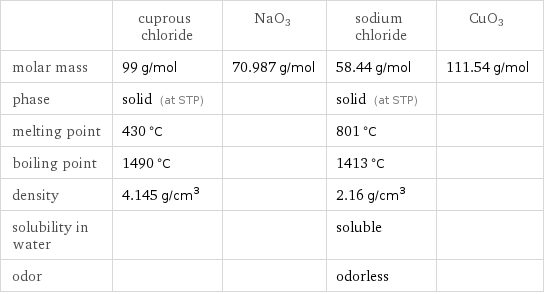Input interpretation

CuCl cuprous chloride + NaO3 ⟶ NaCl sodium chloride + CuO3
Balanced equation

Balance the chemical equation algebraically: CuCl + NaO3 ⟶ NaCl + CuO3 Add stoichiometric coefficients, c_i, to the reactants and products: c_1 CuCl + c_2 NaO3 ⟶ c_3 NaCl + c_4 CuO3 Set the number of atoms in the reactants equal to the number of atoms in the products for Cl, Cu, Na and O: Cl: | c_1 = c_3 Cu: | c_1 = c_4 Na: | c_2 = c_3 O: | 3 c_2 = 3 c_4 Since the coefficients are relative quantities and underdetermined, choose a coefficient to set arbitrarily. To keep the coefficients small, the arbitrary value is ordinarily one. For instance, set c_1 = 1 and solve the system of equations for the remaining coefficients: c_1 = 1 c_2 = 1 c_3 = 1 c_4 = 1 Substitute the coefficients into the chemical reaction to obtain the balanced equation: Answer: | | CuCl + NaO3 ⟶ NaCl + CuO3
Structures

+ NaO3 ⟶ + CuO3
Names

cuprous chloride + NaO3 ⟶ sodium chloride + CuO3
Equilibrium constant
![Construct the equilibrium constant, K, expression for: CuCl + NaO3 ⟶ NaCl + CuO3 Plan: • Balance the chemical equation. • Determine the stoichiometric numbers. • Assemble the activity expression for each chemical species. • Use the activity expressions to build the equilibrium constant expression. Write the balanced chemical equation: CuCl + NaO3 ⟶ NaCl + CuO3 Assign stoichiometric numbers, ν_i, using the stoichiometric coefficients, c_i, from the balanced chemical equation in the following manner: ν_i = -c_i for reactants and ν_i = c_i for products: chemical species | c_i | ν_i CuCl | 1 | -1 NaO3 | 1 | -1 NaCl | 1 | 1 CuO3 | 1 | 1 Assemble the activity expressions accounting for the state of matter and ν_i: chemical species | c_i | ν_i | activity expression CuCl | 1 | -1 | ([CuCl])^(-1) NaO3 | 1 | -1 | ([NaO3])^(-1) NaCl | 1 | 1 | [NaCl] CuO3 | 1 | 1 | [CuO3] The equilibrium constant symbol in the concentration basis is: K_c Mulitply the activity expressions to arrive at the K_c expression: Answer: | | K_c = ([CuCl])^(-1) ([NaO3])^(-1) [NaCl] [CuO3] = ([NaCl] [CuO3])/([CuCl] [NaO3])](../image_source/9fb9f1ce61556e43f4c3a9609b5ee86c.png)
Construct the equilibrium constant, K, expression for: CuCl + NaO3 ⟶ NaCl + CuO3 Plan: • Balance the chemical equation. • Determine the stoichiometric numbers. • Assemble the activity expression for each chemical species. • Use the activity expressions to build the equilibrium constant expression. Write the balanced chemical equation: CuCl + NaO3 ⟶ NaCl + CuO3 Assign stoichiometric numbers, ν_i, using the stoichiometric coefficients, c_i, from the balanced chemical equation in the following manner: ν_i = -c_i for reactants and ν_i = c_i for products: chemical species | c_i | ν_i CuCl | 1 | -1 NaO3 | 1 | -1 NaCl | 1 | 1 CuO3 | 1 | 1 Assemble the activity expressions accounting for the state of matter and ν_i: chemical species | c_i | ν_i | activity expression CuCl | 1 | -1 | ([CuCl])^(-1) NaO3 | 1 | -1 | ([NaO3])^(-1) NaCl | 1 | 1 | [NaCl] CuO3 | 1 | 1 | [CuO3] The equilibrium constant symbol in the concentration basis is: K_c Mulitply the activity expressions to arrive at the K_c expression: Answer: | | K_c = ([CuCl])^(-1) ([NaO3])^(-1) [NaCl] [CuO3] = ([NaCl] [CuO3])/([CuCl] [NaO3])
Rate of reaction
![Construct the rate of reaction expression for: CuCl + NaO3 ⟶ NaCl + CuO3 Plan: • Balance the chemical equation. • Determine the stoichiometric numbers. • Assemble the rate term for each chemical species. • Write the rate of reaction expression. Write the balanced chemical equation: CuCl + NaO3 ⟶ NaCl + CuO3 Assign stoichiometric numbers, ν_i, using the stoichiometric coefficients, c_i, from the balanced chemical equation in the following manner: ν_i = -c_i for reactants and ν_i = c_i for products: chemical species | c_i | ν_i CuCl | 1 | -1 NaO3 | 1 | -1 NaCl | 1 | 1 CuO3 | 1 | 1 The rate term for each chemical species, B_i, is 1/ν_i(Δ[B_i])/(Δt) where [B_i] is the amount concentration and t is time: chemical species | c_i | ν_i | rate term CuCl | 1 | -1 | -(Δ[CuCl])/(Δt) NaO3 | 1 | -1 | -(Δ[NaO3])/(Δt) NaCl | 1 | 1 | (Δ[NaCl])/(Δt) CuO3 | 1 | 1 | (Δ[CuO3])/(Δt) (for infinitesimal rate of change, replace Δ with d) Set the rate terms equal to each other to arrive at the rate expression: Answer: | | rate = -(Δ[CuCl])/(Δt) = -(Δ[NaO3])/(Δt) = (Δ[NaCl])/(Δt) = (Δ[CuO3])/(Δt) (assuming constant volume and no accumulation of intermediates or side products)](../image_source/e6e86e24560cda3ba28f1eb56ee27fae.png)
Construct the rate of reaction expression for: CuCl + NaO3 ⟶ NaCl + CuO3 Plan: • Balance the chemical equation. • Determine the stoichiometric numbers. • Assemble the rate term for each chemical species. • Write the rate of reaction expression. Write the balanced chemical equation: CuCl + NaO3 ⟶ NaCl + CuO3 Assign stoichiometric numbers, ν_i, using the stoichiometric coefficients, c_i, from the balanced chemical equation in the following manner: ν_i = -c_i for reactants and ν_i = c_i for products: chemical species | c_i | ν_i CuCl | 1 | -1 NaO3 | 1 | -1 NaCl | 1 | 1 CuO3 | 1 | 1 The rate term for each chemical species, B_i, is 1/ν_i(Δ[B_i])/(Δt) where [B_i] is the amount concentration and t is time: chemical species | c_i | ν_i | rate term CuCl | 1 | -1 | -(Δ[CuCl])/(Δt) NaO3 | 1 | -1 | -(Δ[NaO3])/(Δt) NaCl | 1 | 1 | (Δ[NaCl])/(Δt) CuO3 | 1 | 1 | (Δ[CuO3])/(Δt) (for infinitesimal rate of change, replace Δ with d) Set the rate terms equal to each other to arrive at the rate expression: Answer: | | rate = -(Δ[CuCl])/(Δt) = -(Δ[NaO3])/(Δt) = (Δ[NaCl])/(Δt) = (Δ[CuO3])/(Δt) (assuming constant volume and no accumulation of intermediates or side products)
Chemical names and formulas

| cuprous chloride | NaO3 | sodium chloride | CuO3 formula | CuCl | NaO3 | NaCl | CuO3 Hill formula | ClCu | NaO3 | ClNa | CuO3 name | cuprous chloride | | sodium chloride |
Substance properties

| cuprous chloride | NaO3 | sodium chloride | CuO3 molar mass | 99 g/mol | 70.987 g/mol | 58.44 g/mol | 111.54 g/mol phase | solid (at STP) | | solid (at STP) | melting point | 430 °C | | 801 °C | boiling point | 1490 °C | | 1413 °C | density | 4.145 g/cm^3 | | 2.16 g/cm^3 | solubility in water | | | soluble | odor | | | odorless |
Units
